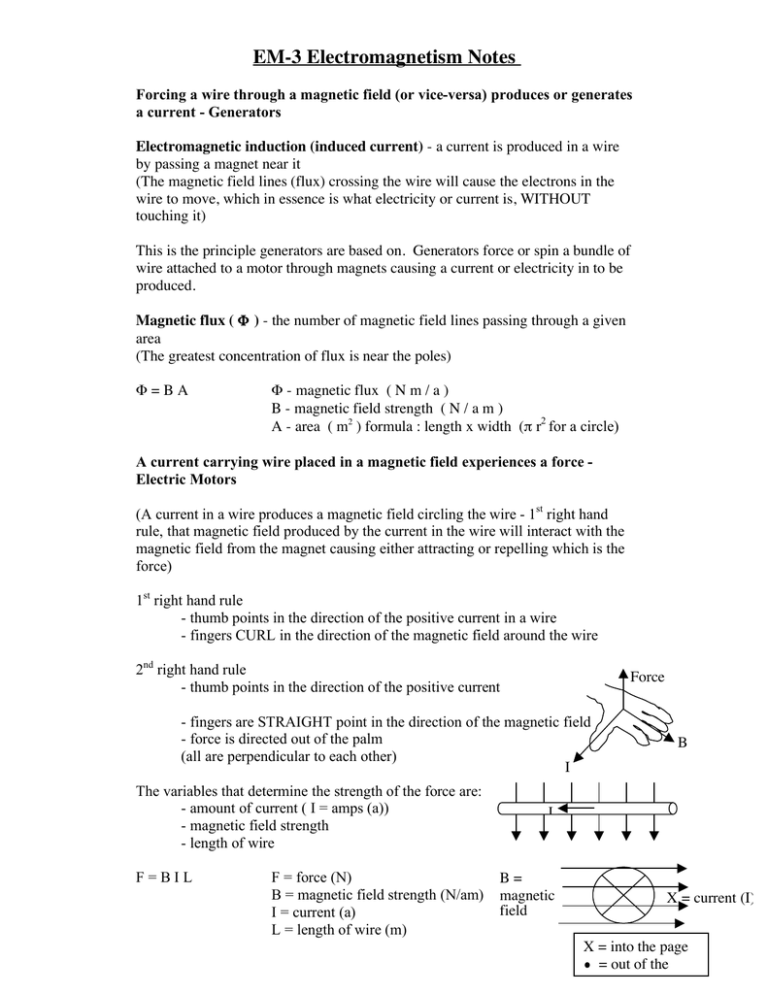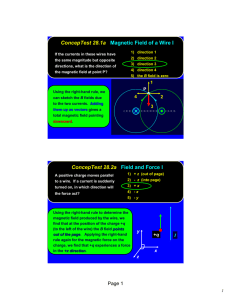EM-3 tv notes 09 - Moline High School
advertisement

EM-3 Electromagnetism Notes Forcing a wire through a magnetic field (or vice-versa) produces or generates a current - Generators Electromagnetic induction (induced current) - a current is produced in a wire by passing a magnet near it (The magnetic field lines (flux) crossing the wire will cause the electrons in the wire to move, which in essence is what electricity or current is, WITHOUT touching it) This is the principle generators are based on. Generators force or spin a bundle of wire attached to a motor through magnets causing a current or electricity in to be produced. Magnetic flux ( Φ ) - the number of magnetic field lines passing through a given area (The greatest concentration of flux is near the poles) Φ=BA Φ - magnetic flux ( N m / a ) B - magnetic field strength ( N / a m ) A - area ( m2 ) formula : length x width (π r2 for a circle) A current carrying wire placed in a magnetic field experiences a force Electric Motors (A current in a wire produces a magnetic field circling the wire - 1st right hand rule, that magnetic field produced by the current in the wire will interact with the magnetic field from the magnet causing either attracting or repelling which is the force) 1st right hand rule - thumb points in the direction of the positive current in a wire - fingers CURL in the direction of the magnetic field around the wire 2nd right hand rule - thumb points in the direction of the positive current Force - fingers are STRAIGHT point in the direction of the magnetic field - force is directed out of the palm (all are perpendicular to each other) I The variables that determine the strength of the force are: - amount of current ( I = amps (a)) - magnetic field strength - length of wire F=BIL F = force (N) B = magnetic field strength (N/am) I = current (a) L = length of wire (m) B I B= magnetic field X = current (I) X = into the page = out of the page Voltage – energy needed to move a charge (electric potential) Relative motion - the movement of one object with respects to another Lenz’s Law - the current induced in a wire is in such a direction that its magnetic field is opposite the magnetic field that induced it Faraday’s Law - Voltage (emf) induced in a wire is proportional to the rate of magnetic flux (magnetic field lines) crossing the wire EMF - Potential difference produced by electromagnetic induction (Voltage created by forcing a wire through a magnetic field) Transformers – A device to increase (step-up transformer) or decrease (stepdown transformer) voltage N1 = V1 N2 V2 Volts Volts s Iron Core 10 turns 5 turns If the primary coil having 5 turns of wire contains 20 volts, what is the voltage in the secondary coil having 10 turns? 5 turns = 20 V 10 turns X 5 X = 200 X = 40 V



